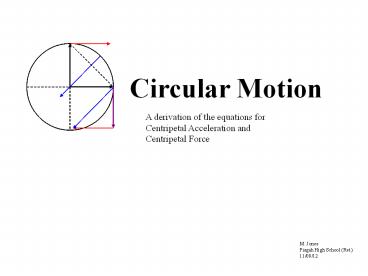Circular Motion - PowerPoint PPT Presentation
1 / 9
Title:
Circular Motion
Description:
Circular Motion A derivation of the equations for Centripetal Acceleration and Centripetal Force M. Jones Pisgah High School (Ret.) 11/09/12 movement of an object at ... – PowerPoint PPT presentation
Number of Views:481
Avg rating:3.0/5.0
Title: Circular Motion
1
Circular Motion
A derivation of the equations for Centripetal
Acceleration and Centripetal Force
M. Jones Pisgah High School (Ret.) 11/09/12
2
movement of an object at a constant a velocity in
a straight line
a force is exerted on the object at right angles
Centripetal force is defined as a force acting at
right angles to the direction of motion.
centripetal force
The centripetal force will cause a change in
direction, resulting in circular motion.
centripetal force
3
The centripetal force will cause a change in
direction, resulting in circular motion.
A force acting on an object produces acceleration
according to Newton's second law. F ma The
centripetal force produces a centripetal
acceleration.
While the magnitude of the tangential velocities
of the object remains constant, the direction is
constantly changing. Acceleration is defined as
a change in velocity over time. Since velocity
is a vector composed of both direction and
magnitude, a change in either quantity over time
is a change in velocity. Therefore, the object
must be accelerating even though its tangential
speed remains constant.
4
Acceleration is defined as a change in velocity
over a change in time.
The first step in finding the centripetal
acceleration is to determine the change in
velocity, Dv.
Dv vf - vi
5
Dv vf - vi
We can find Dv graphically by adding the vectors
tip-to-tail. Since Dv is the difference, we can
add the inverse of the initial velocity. That
simply means that we will reverse the direction.
Dv is the vector from the tail of the first
vector to the tip of the last vector.
vf
Dv
- vi
Since vi and vf have the same magnitude, v, the
value for Dv is determined from the Pythagorean
formula.
6
If we slide Dv up into the circle and start it at
the midpoint of the arc between vi and vf, we see
that the change in velocity is directed to the
center of the circle. This means that the
centripetal acceleration and the centripetal
force are also directed toward the center of the
circle.
But that still leaves us with the question of how
do we determine the equation for centripetal
acceleration.
7
The distance the object travels between the
initial and final points on the circle is given
by Ds, the displacement.
vi
r
Ds
We can determine Ds from the Pythagorean formula.
r
vf
8
Since both terms are equal to ?2, we can set
them equal.
Since Ds vDT, we can substitute
Rearrange v and Dt
Since aDv/Dt and Fma, we get the equations for
centripetal acceleration and centripetal force
9
(No Transcript)

